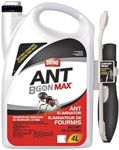We Use CookiesWe use cookies to enhance the security, performance,
functionality and for analytical and promotional activities. By continuing to browse this site you
are agreeing to our privacy policy
Best Outdoor Ant Killers
From leading brands and best sellers available on the web.#2

Generic
22%OFF
Ant B Gon Max Ant Control, 4-L
View Product
#3

Ortho
Ortho Ant B Gon Max Ant Killer Granules 450 g
View Product
#4

Terro
38%OFF
TERRO T1812CAN Outdoor Liquid Ant Bait Stakes
View Product
Buying Guide for the Best Outdoor Ant Killers
Choosing the right outdoor ant killer can make a big difference in how effectively you control ant problems around your home or garden. The best product for you depends on the type of ants you’re dealing with, the size of the area you need to treat, and your preferences regarding safety and environmental impact. Understanding the key features and specifications will help you make a choice that fits your needs and keeps your outdoor spaces ant-free.Type of Ant KillerOutdoor ant killers come in several forms, such as sprays, granules, baits, and powders. This specification refers to how the product is applied and how it works. Sprays are good for immediate action on visible ants, granules and powders can be spread over larger areas for ongoing control, and baits attract ants to carry poison back to the colony. If you need quick results for a small area, sprays or powders might be best. For long-term control or larger infestations, baits and granules are more effective. Your choice should depend on whether you want fast action or lasting protection, and how much area you need to cover.
Active IngredientThe active ingredient is the chemical or natural substance that kills the ants. Common active ingredients include synthetic chemicals like bifenthrin or permethrin, and natural options like borax or diatomaceous earth. Chemical ingredients usually work faster and are more potent, but may pose risks to pets, children, or beneficial insects. Natural ingredients are safer for the environment and non-target animals, but may take longer to work. If you have pets or children playing outside, or if you’re concerned about environmental impact, look for products with natural active ingredients. For severe infestations where quick results are needed, chemical options may be more suitable.
Residual EffectResidual effect refers to how long the ant killer continues to work after application. Some products kill ants on contact but offer little ongoing protection, while others leave a residue that keeps killing ants for weeks or even months. If you want to prevent ants from returning, choose a product with a longer residual effect. If you only need to deal with a one-time problem, a product with a short or no residual effect may be enough. Consider how often you want to reapply the product and whether you need ongoing protection.
Coverage AreaCoverage area tells you how much ground the product can treat, usually measured in square feet or meters. This is important for making sure you buy enough product for your needs. Small containers are suitable for spot treatments or small gardens, while larger packages are better for treating lawns, patios, or bigger outdoor spaces. Estimate the size of the area you need to treat and choose a product that matches or exceeds that coverage to ensure effective control.
Safety and Environmental ImpactThis specification covers how safe the product is for people, pets, and the environment. Some ant killers are toxic to animals, birds, or aquatic life, while others are designed to be safe for use around children and pets. If you have pets, children, or a garden with edible plants, look for products labeled as safe for these situations. If you’re concerned about pollinators or local wildlife, choose products with minimal environmental impact. Always read the label and follow safety instructions to minimize risks.
Ease of ApplicationEase of application refers to how simple and convenient it is to use the product. Some ant killers require mixing or special equipment, while others come ready to use in easy-to-apply packaging. If you prefer a hassle-free experience, look for products that are ready to use and have clear instructions. If you’re treating a large area or need to target hard-to-reach places, consider how the product is applied and whether it fits your needs.

